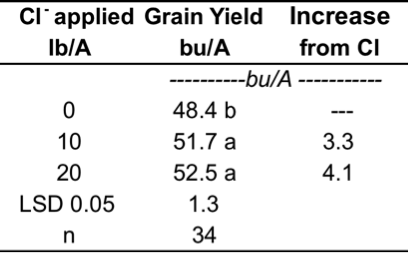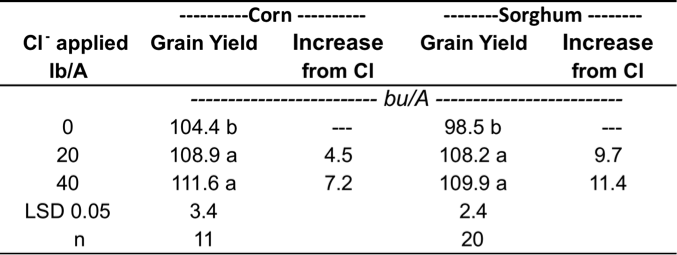Chloride (Cl-) was first generally recognized as a plant nutrient in the mid 1950s; however, its value as a fertilizer supplement was not appreciated until the 1970s when work in the northwestern United States and elsewhere showed that crops do indeed respond to Cl- fertilizer application. Since that time, there has been a great deal of work investigating crop response to the addition of Cl-, and determining optimal management practices for Cl- fertilization.
As is the case with any crop nutrient, simple questions such as “what are its sources in soils, how does it behave, and where is it needed?” are fundamental to effective management. Chloride occurs in soils and plants as an anion. It is highly mobile, and is therefore subject to leaching in soils much like nitrate (NO₃-). It can be added to soils from the atmosphere, depending on proximity to seashores. Near shorelines, marine aerosols containing Cl- can be carried inland and deposited, with levels of deposition decreasing as the aerosols move inland. Fields and farms with a history of potassium (K) fertilization are less likely to need Cl- since the major source of fertilizer K is muriate of potash (MOP; KCl), which is 45 to 47 percent Cl-. Also, irrigation water in some areas may contain Cl-. Given these points, it stands to reason that potential areas of need for Cl- are the U.S. Great Plains and Canadian Prairies, considering distance from shorelines, and that soil K levels are usually high enough that K fertilizer is not used on a large scale.
In the Great Plains region, the most commonly observed symptoms from Cl- deficiency are seen on wheat. These symptoms appear as leaf spotting and are referred to as physiological leaf spot (see image). Some varieties are more likely to exhibit visual Cl- deficiency symptoms than others ( Lamond and Leikam, 2002). Visible Cl- deficiency symptoms have not been well defined for most other agronomic crops, including corn and sorghum, although yield responses have been observed. Chloride performs several internal functions in crops, but it’s probably most recognized for the effect it has in suppression of diseases such as leaf rust in wheat.

Classic chloride “leaf spotting” deficiency symptoms (left) in winter wheat.
Some of the most notable work on Cl- nutrition has been done in Kansas. Kansas State University (KSU) Extension scientists have conducted scores of Cl- trials since the 1980s, mostly on winter wheat, with some on corn and grain sorghum as well. Most of the Kansas work has been published in the Kansas Fertilizer Report, Better Crops magazine (BC) and other outlets. Kansas Cl- research has more recently been conveniently summarized in a BC article ( Mengel et al., 2009). Tables 1 and 2 summarize data from this article for wheat, corn and grain sorghum trials over about a 10- to 15-year period. It is important to note that the tables include means from both responsive and nonresponsive sites, and that if only responsive sites were evaluated, yield increases due to Cl- application would have been greater. Nevertheless, across all sites, wheat response was in the 3- to 4-bushel range for 10 lbs Cl-/ac; corn was about 5 bu/ac; and sorghum 10 bu/ac for 20 lbs/ac Cl- application.
Several sources of Cl- fertilizer may be available to farmers (e.g., KCl, MgCl2, NH4Cl), but by far, the most commonly available source is usually going to be KCl. Research in Kansas and elsewhere has shown that there is no difference in performance among sources.
Conditions favoring response to Cl- fertilizer application have been identified by KSU scientists ( Lamond and Leikam, 2002; Leikam et al., 2003) and others. In addition to field history, both soil and tissue testing can be useful tools in helping identify the need for Cl-.
The value of Cl- as a fertilizer input has been proven by decades of research and investigation — it is now up to farmers and their advisers to see that yield and profit opportunities from Cl- nutrition are not overlooked.

Table 1. Response of wheat to chloride fertilization in Kansas (derived from 34 experiments conducted from 1990–2006).
Source: Mengel et al., 2009.

Table 2. Response of dryland corn and grain sorghum to applied chloride fertilizer in Kansas. (Corn data derived from 11 studies conducted from 1990–2006; sorghum data derived from 20 site years from 1996–2006). Source: Mengel et al., 2009.